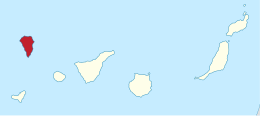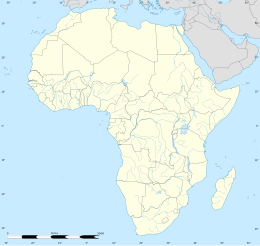 Satellite view of La Palma | |
 Location of La Palma within the Canary Islands | |
| Geography | |
|---|---|
| Location | Atlantic Ocean |
| Coordinates | 28°40′N 17°52′W / 28.667°N 17.867°W |
| Archipelago | Canary Islands |
| Area | 708.32 km2 (273.48 sq mi)[1] |
| Coastline | 166 km (103.1 mi)[1] |
| Highest elevation | 2,426 m (7959 ft)[1] |
| Highest point | Roque de los Muchachos |
| Administration | |
| Autonomous Community | Canary Islands |
| Province | Santa Cruz de Tenerife |
| Capital city | Santa Cruz de La Palma |
| Largest settlement | Los Llanos de Aridane (pop. 20,375 (2023)) |
| Demographics | |
| Demonym | palmero/a |
| Population | 84,338 (start of 2023)[2][3] |
| Pop. density | 119.1/km2 (308.5/sq mi) |
| Languages | Spanish, specifically Canarian Spanish |
| Ethnic groups | Spanish, Canary Islanders, other minority groups |
| Additional information | |
| Time zone | |
| • Summer (DST) | |
La Palma (Spanish: [la ˈpalma] , local pronunciation: [lɐ ˈpɑ(l)mɐ]), also known as La isla bonita (English: The Beautiful Island) and historically San Miguel de La Palma, is the most northwesterly island of the Canary Islands, Spain, which is a Spanish autonomous community and archipelago in Macaronesia in the North Atlantic Ocean. La Palma has an area of 708.32 square kilometres (273.48 sq mi) making it the fifth largest of the eight main Canary Islands. The total population at the start of 2023 was 84,338,[4][3] of which 15,522 lived in the capital, Santa Cruz de La Palma and 20,375 in Los Llanos de Aridane. Its highest mountain is the Roque de los Muchachos, at 2,426 metres (7,959 ft), being second among the peaks of the Canaries after the Teide massif on Tenerife.
In 1815, the German geologist Leopold von Buch visited the Canary Islands. It was as a result of his visit to Tenerife, where he visited the Las Cañadas caldera, and then later to La Palma, where he visited the Taburiente caldera, that the Spanish word for cauldron or large cooking pot – "caldera" – was introduced into the geological vocabulary. In the center of the island is the Caldera de Taburiente National Park, one of four national parks in the Canary Islands.
- ^ a b c "Estadística del Territorio" [Territory Statistics] (in Spanish). Instituto Canario de Estadística (ISTAC). Retrieved 14 August 2019.
- ^ Instituto Nacional de Estadistica, Madrid, 2023.
- ^ a b "This statistic displays the population of the Spanish autonomous community of the Canary Islands* in January 2020, by island". Statista.com. October 2020. Retrieved 17 June 2020.
- ^ Instituto Nacional de Estadistica, Madrid, 2023.
